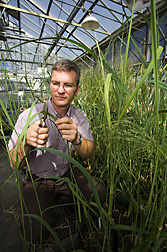Washington, DC, USA
July 27, 2010
 Agricultural Research Service (ARS) scientists have developed a new tool for deciphering the genetics of a native prairie grass being widely studied for its potential as a biofuel. The genetic map of switchgrass, published by Christian Tobias, a molecular biologist at the ARS Western Regional Research Center in Albany, Calif., and his colleagues, is expected to speed up the search for genes that will make the perennial plant a more viable source of bioenergy.
Agricultural Research Service (ARS) scientists have developed a new tool for deciphering the genetics of a native prairie grass being widely studied for its potential as a biofuel. The genetic map of switchgrass, published by Christian Tobias, a molecular biologist at the ARS Western Regional Research Center in Albany, Calif., and his colleagues, is expected to speed up the search for genes that will make the perennial plant a more viable source of bioenergy.
Switchgrass is now grown as a cattle feed and to restore depleted soils. But interest in using it as a biofuel has intensified in recent years because it can be burned to produce electricity and, like corn stalks, can be converted to ethanol. It also grows on marginal lands, is adaptable to different regions, and—as a perennial—does not need to be replanted each year, which means lower energy costs and less runoff.
To assemble the genetic map, the team crossed a commercial variety of switchgrass known as Kanlow with an ARS-developed variety known as Alamo to produce 238 plants. They extracted DNA from that population and assembled a map based on more than 1,000 genetic markers that could each be attributed to one parent or the other.
The map divides the switchgrass genome into 18 distinct groups of genes linked together on the same strand of DNA. The results were recently published in the journal Genetics.
The work is funded by the U.S. Department of Energy and the U.S. Department of Agriculture (USDA) National Institute of Food and Agriculture, as part of the joint USDA-DOE Plant Feedstock Genomics for Bioenergy Program.
Understanding the genetic composition of switchgrass could produce big rewards. To make switchgrass more commercially viable as a biofuel, scientists are searching for ways to increase yields and make it easier to break down the plant cell walls, an essential step in producing ethanol from cellulosic biomass.
The genetic map could lead to genes associated with cell wall composition, crop yields and other useful traits. Scientists will be able to use the genetic map to compare the genetic profile of switchgrass to that of rice, sorghum and other plants with better understood genomes and find analogues to genes linked to specific traits in those crops.
ARS is the principal intramural scientific research agency of USDA. The work supports the USDA priority of developing new sources of bioenergy.
Photo: Molecular biologist Christian Tobias samples switchgrass plants for later extraction of DNA. Photo by Peggy Greb.
Una nueva herramienta para mejorar el césped Panicum virgatum
Científicos del Servicio de Investigación Agrícola (ARS) han desarrollado una nueva herramienta para descifrar la genética del césped Panicum virgatum, el cual es estudiado como una fuente posible de biocombustible.
Se espera que este mapa genético de Panicum virgatum, publicado por biólogo molecular Christian Tobias y sus colegas en el Centro de Investigación de la Región Occidental mantenido por el ARS en Albany, California, acelere la búsqueda para los genes que convertirán esta planta perenne en una fuente más viable de bioenergía.
Ahora el césped Panicum virgatum se cultiva como una fuente de pienso y para restaurar los suelos agotados. Pero hay un interés creciente en utilizar esta planta como una materia prima de biocombustible porque se puede quemarla para producir electricidad y, semejante a los tallos de maíz, se puede convertirla en etanol. Esta planta crece en los suelos pocos productivos, es adaptable a diferentes regiones, y porque es una planta perenne, no requiere replantación cada año, de este modo reduciendo los costos de energía y el escurrimiento de los campos.
Para crear el mapa genético, los investigadores cruzaron la variedad comercial 'Kanlow' de Panicum virgatum con una variedad llamada 'Alamo', la cual fue desarrollada por ARS, para producir 238 plantas. Luego extrajeron el ADN de esta población de plantas y crearon un mapa basado en más de 1.000 marcadores genéticos que se pueden atribuir a o un padre o otro.
El mapa divide el genoma de Panicum virgatum en 18 grupos distintos de genes enlazados juntos en el mismo pedazo de ADN. Los resultados de esta investigación fueron publicados recientemente en la revista 'Genetics' (Genética).
Esta investigación fue patrocinada por el Departamento de Energía de EE.UU. (DOE por sus siglas en inglés) y el Instituto Nacional de Alimentos y Agricultura (NIFA por sus siglas en inglés) del Departamento de Agricultura de EE.UU. (USDA por sus siglas en inglés), como parte del Programa de la Genómica de Materias Primas Vegetales para Bioenergía, el cual es un programa cooperativo de USDA y DOE.
Entender la composición genética del césped Panicum virgatum podría proveer muchos beneficios. Para mejorar la viabilidad del césped como una fuente de biocombustible, los científicos están buscando maneras de aumentar los rendimientos de las plantas y de facilitar la descomposición de las paredes celulares de la planta, la cual es un paso imprescindible en producir etanol de la biomasa celulósica.
El mapa genético podría llevar al descubrimiento de genes asociados con la composición de las paredes celulares, los rendimientos, y otros rasgos útiles. Científicos podrán utilizar el mapa para comparar el perfil genético de Panicum virgatum con otras plantas tales como arroz y sorgo para mejor entender los genomas y descubrir análogos a los genes asociados con rasgos específicos en esos cultivos.
ARS es la agencia principal de investigaciones científicas del USDA. Esta investigación apoya la prioridad del USDA de promover la seguridad alimentaria internacional.